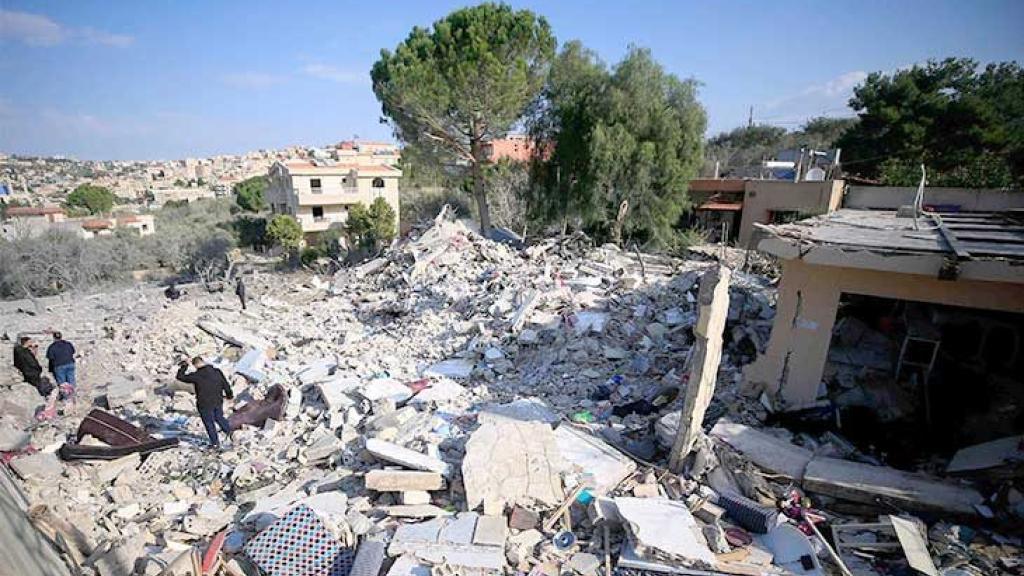The Zionist destruction machine threatens Lebanon after Gaza

First published at Gilbert Achcar's blog.
Two weeks ago, we estimated, in light of the evidence available at the time, that Israel’s occupation forces would stop their intensive campaign of heavy bombardment at the beginning of this new year, and shift to a “low-intensity war” whose goal would be to tighten control over most of the territory of the Gaza Strip fallen under its sway, eradicate all remaining resistance within it and destroy the network of tunnels that remain under its soil (see “Whither Israel’s War on Gaza?”, 20/12/2023). On Monday, the first day of this new year, the official spokesman for the occupation army announced the withdrawal of five brigades from Gaza, composed mostly of reserve soldiers, in what was interpreted by observers as a first step towards the shift to a “low-intensity war” as promised by Israel’s rulers to their external supporters, the United States above all.
The truth is that, for both human and economic reasons, the Zionist state cannot carry on for long waging a war with the same intensity as the one it has fought since “Al-Aqsa Flood”. This is because Israel is a relatively small country, with a Jewish population of only a little more than seven million, of whom a million and a half are men of military service age (in addition to a million and a half women who have not been involved in the war yet). It cannot continue to mobilize approximately half a million reservists for a long period, as this constitutes a heavy human burden on its society and an even heavier burden on its economy.
Until the end of last year, that is, in less than three months, the war has cost approximately 20 billion dollars, according to what a former deputy governor of the Israeli Central Bank told the Washington Post, i.e. a cost approaching a quarter of a billion dollars per day, which is huge for the country’s economy. The Zionist government estimates that the entire war, which Prime Minister Benjamin Netanyahu confirmed last Saturday would last at least a year, will cost it about 50 billion dollars (that is, approximately one tenth of Israel’s GDP). What makes Netanyahu and his allies of the Zionist far right all the more determined to continue the war at a lower intensity throughout this new year is their bet on Donald Trump’s victory in the US presidential election next autumn. They believe that Trump would give them a green light to complete the “Second Nakba” by permanently seizing the Gaza Strip and annexing it. As they rely on American funding to mitigate the impact of the war on their economy, they must reduce its costs so that they can carry it on during the next several months as they intend.
At the same time, however, the Zionist government is planning a second intensive bombing campaign that would start once the intensity of its bombing of Gaza is reduced. During the very first days of Israel’s new offensive, Zionist “Defence” Minister, former Major General Yoav Galant, a member of the Likud Party and a rival of Netanyahu, was reported to want Israel to attack Hezbollah in Lebanon in conjunction with its onslaught on Hamas in Gaza. Gallant is known to be an advocate of the Dahiya doctrine, applied for the first-time during Israel’s onslaught on Lebanon in 2006. This military strategy consists in responding to anyone who threatens Israel’s security in such a sweeping and destructive way that it would constitute a powerful deterrent. As head of the Southern Command between 2005 and 2010, Gallant oversaw the application of that doctrine in the deadly three-week onslaught on Gaza that started at the end of 2008.
Last summer, the Zionist “Defence” Minister threatened to return Lebanon to the “stone age”. This was after he inspected the Shebaa Farms area on the Lebanese border and saw a tent set up by Hezbollah there. He said at the time: “I warn Hezbollah and Nasrallah not to make mistakes. You have made mistakes in the past and paid a very high price. If, God forbid, escalation or confrontation happens here, we will return Lebanon to the Stone Age.” He continued, repeating: “I warn Hezbollah and its leader: Do not make a mistake. We will not hesitate to use all our power and destroy every meter belonging to Hezbollah and Lebanon if we have to.” He then added, “When it comes to Israel’s security, we are all united.” These last words were in response to the assertion by Hezbollah’s leader that Israel has been weakened due to its political crisis.
Thus, the likelihood of a new massive aggression launched by the Zionist state against Lebanon has become very high indeed. The Israeli government is putting Hezbollah in a corner by demanding that it withdraw its military presence to north of the Litani River, some 10 km north of Lebanon’s border, as compliance would cause the party to lose face while refusal to comply would make it bear responsibility for causing a new devastating aggression against Lebanon, the areas where the party is deployed in particular. Hezbollah’s limited intervention in the wake of “Al-Aqsa Flood” has thus backfired, as the party missed the opportunity to force Israel to engage in an intensive war on two fronts whereas Israel is today threatening to launch an intensive bombardment of Lebanon, singling it out after completing its intensive bombardment of Gaza.